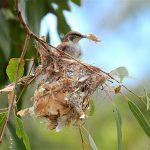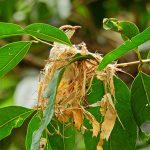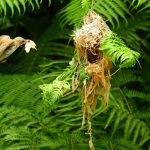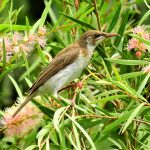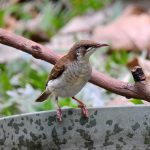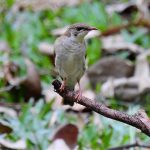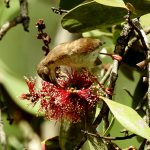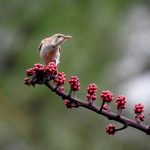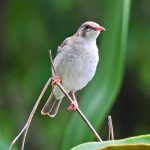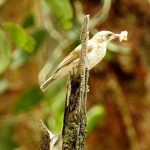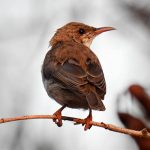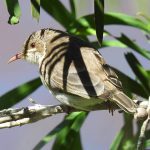BROWN-BACKED HONEYEATER
(Ramsayornis modestus)
This small, unassuming bird, with its modest brown plumage that seamlessly blends into the Australian bush, plays a significant role in the biodiversity of its habitat.
The Brown-backed Honeyeater primarily calls the mangrove forests and dense woodlands of northern Australia home. From the coastal stretches of Queensland to the Northern Territory, these birds thrive in the humid, tropical climate, often found flitting about in the dense foliage, almost as if they are playing hide and seek with the sun.
When it comes to family life, the Brown-backed Honeyeater is quite the architect. They construct their nests as delicate cups woven from grass and spider webs, suspended from the thin branches of trees or shrubs. Breeding season sees these birds becoming industrious builders, ensuring their nests are both secure and hidden away from potential predators. They typically lay two to three eggs, which are incubated for about 14 days. Both parents are devoted caretakers, sharing the duties of feeding the chicks until they are ready to venture out into the world on their own.
As their name suggests, honeyeaters have a sweet tooth, so to speak. Their diet primarily consists of nectar, which they skillfully extract from flowers using their specially adapted tongues. However, they are not just nectar feeders. These birds are also insectivores, hunting for small insects and spiders to complement their diet. This varied diet is crucial for their survival, especially during breeding season when the demand for energy is high.
Despite their resilience and adaptability, Brown-backed Honeyeaters face several threats. Habitat destruction, primarily due to land clearing for agriculture and urban development, poses a significant risk to their populations. Additionally, climate change and the resulting shifts in their natural habitat can impact their food sources and nesting sites, further threatening their survival.
One of the most intriguing aspects of the Brown-backed Honeyeater is their social behavior. They are known to be quite gregarious outside the breeding season, forming small flocks that move through the forest in search of food. Their calls, a mix of melodious chirps and whistles, add a layer of auditory beauty to their habitat, creating an enchanting symphony that resonates through the Australian bush.
The Brown-backed Honeyeater, with its modest appearance and remarkable adaptability, is a testament to the incredible biodiversity of Australia’s northern regions. Their presence enriches the ecosystems they inhabit, playing a crucial role in the pollination of native plants. As we continue to learn about these fascinating birds, it’s vital to remember the importance of preserving their habitats, ensuring that future generations can also marvel at their beauty and ecological significance.

